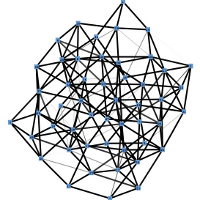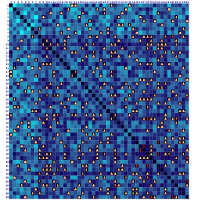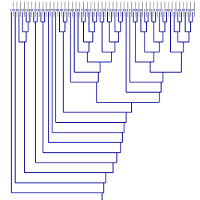Software
For publicly funded research units in the field of computer science the publication of open source software constitutes one way of knowledge transfer, giving back to the public what belongs to the public. Software developed at the Chair of Human-Computer Interaction is provided here with only some usage restrictions such as non-commerciality.
Extended Growing Neural Gas

TGNG - An Extended Growing Neural Gas Implementation for ROOT
Author: Jochen Kerdels
Version 1.50
tgng_1_5.zip, licensed under CC BY-NC-SA 4.0 International 
The use of this material for military and/or intelligence purposes is disapproved of.

The "Growing Neural Gas" (GNG) is a prototype-based vector quantization method proposed by Bernd Fritzke [1]. This implementation features several extensions to the GNG like local input space histograms [2], hierarchical clustering of GNG units, and several types of visualization. The code provides a simple and easy to use interface to implement custom input data types, distance measures, and extensions.
This updated version of the TGNG package allows to simulate grid cells, that were found in the entorhinal cortex of rats, by a dendritic, self-organized learning process [3]. Grid cells are simulated by the "Recursive Growing Neural Gas" (RGNG) algorithm proposed in [4], which is a recursive version of the GNG. A short summary on how to use the implementation of the RGNG to perform such a simulation is given in doc/GRID_CELL_SIM .

The implementation provided here is intended to be used with the data analysis framework ROOT (root.cern.ch) developed at CERN. It is recommended that you use ROOT version 6.00 or later, although the code may compile and run (untested) with prior versions of ROOT. The code and all other files of this package are licensed under CC BY-NC-SA 4.0 International.
[1] Bernd Fritzke,
A Growing Neural Gas Network Learns Topologies,
Advances in Neural Information Processing Systems 7, MIT Press, pp. 625-632, 1995.

[2] Jochen Kerdels & Gabriele Peters,
Supporting GNG-based Clustering with Local Input Space Histograms,
Proceedings of the 22nd European Symposium on Artificial Neural Networks, Computational Intelligence and Machine Learning, pp. 559-564, 2014.
[3] Jochen Kerdels & Gabriele Peters,
A Computational Model of Grid Cells based on Dendritic Self-organized Learning,
Proceedings of the 5th International Joint Conference on Computational Intelligence, SciTePress, pp. 420-429, 2013.
[4] Jochen Kerdels,
A Computational Model of Grid Cells based on a Recursive Growing Neural Gas,
Dissertation at the University of Hagen, 2016.
- Downloads:
- Research Report 2010-2013 (pdf)
- Forschungsbericht 2010-2013 (pdf)
- Lehrbericht 2010-2022 (pdf)
- Legal notice
- © FernUniversität in Hagen
 FernUniversität in Hagen, Faculty of Mathematics und Computer Science, Human-Computer Interaction, 58084 Hagen
FernUniversität in Hagen, Faculty of Mathematics und Computer Science, Human-Computer Interaction, 58084 Hagen

